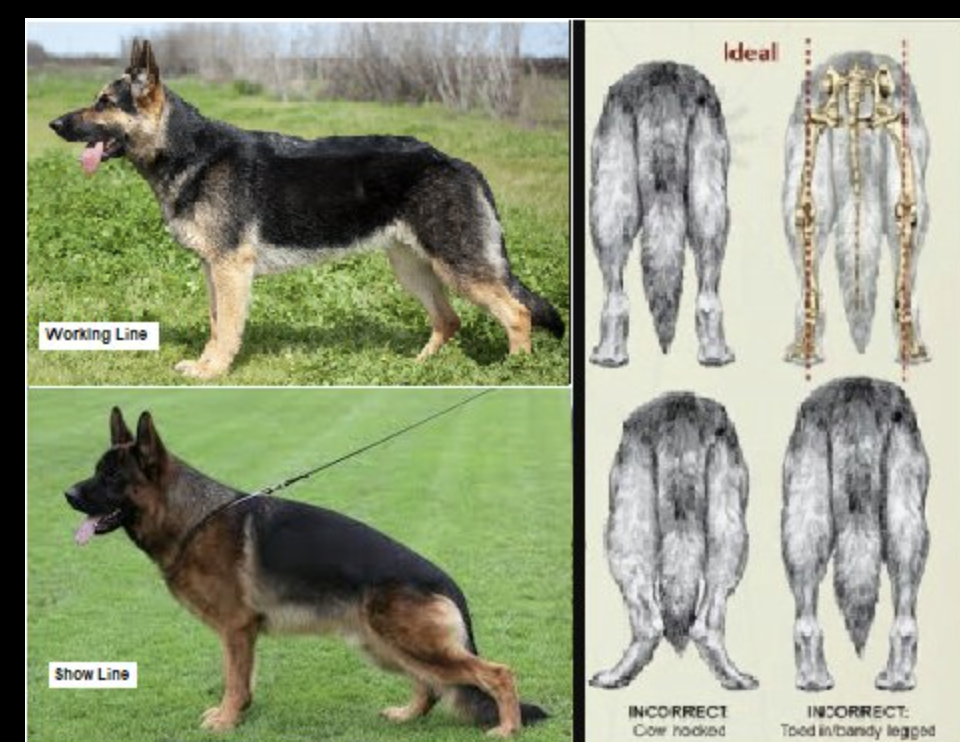
Father
Ch Udo Von Der EschelbronnerSchlosswiese
CKC Champion
One major physical difference between Working Line GSDs and the majority of North American GSDs is the structure and aligment of the back legs and back profile. This is just one reason to be very selective regarding the pedigree.
A STRONG working line component is required to ensure a strong, athletic, driven dog with minimal to no health problems usually associated with North American GSDs.
Note the straigt back profile the Working Line with proper alignment. The lower photo of an AKC Showlline with minimal Working Line Pedigree. The key is to have strong working line pedigree traits in a West German Showline for a family dog.
Although The Working Line GSDs are wonderful, they are simply too driven for most owners. Unless you have a job for them, or compete with them in IGP.
For most, it is advisable to get a West German Showline with a STRONG Working Line / German Pedigree.
That way you ensure your dog is healthy, athletic, a protector of family and property, BUT has an on / off switch. The result, overall, a very civilized dog that is an asset in your life.
Mother & Father of Ch Udo Von Der Eschelbronner Schlosswiese
The father of Atlas Vom Burgimwald. CKC Grand Champion Cappi Vom Burgimwald.

Make it stand out
The German Breeding Program & The Burgimwald GSD
In Germany, dog judging is a highly respected and regulated activity, particularly in the context of dog shows, breed evaluations, and working trials. The terminology used in German dog judging often reflects the country's emphasis on precision, tradition, and breed standards. Below is an overview of key terms and their meanings related to dog judging in Germany:
1. General Terms
Zucht (Breeding): Refers to the practice of breeding dogs with the goal of preserving or improving specific traits according to breed standards.
Rasse (Breed): A specific type of dog with distinct characteristics defined by breed standards.
Richter (Judge): The official responsible for evaluating dogs in shows, trials, or breed assessments.
Ausstellung (Show/Exhibition): A formal event where dogs are judged based on their adherence to breed standards.
2. Dog Show Judging Terms
Verein für Deutsche Schäferhunde (SV): The German Shepherd Dog Club of Germany, which plays a central role in setting breed standards and organizing events like the Sieger Show .
Körung: A rigorous evaluation process for breeding suitability, assessing a dog’s physical structure, temperament, and working ability.
Dogs must pass this test to be approved for breeding.
SchH/IGP Titles: Schutzhund (now called IGP, Internationale Gebrauchshund Prüfung) is a working dog sport that tests a dog's tracking, obedience, and protection skills. These titles are often considered in judging working breeds.
Prüfung (Test/Trial): A formal assessment of a dog’s abilities, such as tracking, obedience, or protection work.
3. Breed Evaluation Terms
Wesenstest (Temperament Test): Evaluates a dog’s temperament, including its confidence, sociability, and reaction to stimuli. This is critical for determining a dog’s suitability as a companion or working animal.
Anlage (Character Traits): Refers to a dog’s inherent temperament and personality traits, which are assessed during evaluations.
Konformation (Conformation): The physical structure and appearance of a dog, judged against the breed standard.
Gebiss (Bite): The alignment and structure of a dog’s teeth, which is crucial for functional purposes (e.g., gripping or carrying objects). A "scissor bite" is often preferred in many breeds.
Gangwerk (Movement/Gait): The way a dog moves, including its stride, balance, and coordination. Judges assess movement at various speeds (walk, trot, gallop).
4. Ratings and Titles
Vorzüglich (V): Excellent: The highest rating a dog can receive in conformation shows. Indicates exceptional adherence to breed standards.
Sehr Gut (SG): Very Good: A strong rating but not quite at the "Excellent" level.
Gut (G): Good: A satisfactory rating, indicating the dog meets basic breed standards but has noticeable flaws.
Genügend (A): Sufficient: A low rating indicating the dog barely meets the minimum requirements.
Nicht Genügend (NG): Not Sufficient: A failing grade, indicating the dog does not meet breed standards.
5. Working Dog Judging Terms
Fährte (Track): In tracking trials, the path laid out for the dog to follow. Judges evaluate the dog’s ability to stay on the track and locate articles.
Unterordnung (Obedience): Tests a dog’s ability to follow commands, perform tasks, and demonstrate discipline.
Schutzdienst (Protection Work): Assesses a dog’s ability to protect its handler, engage with a decoy, and show controlled aggression.
BH/VT Title: Begleithundprüfung/Verkehrstüchtigkeit, a basic obedience and temperament test required before advancing to higher-level working titles.
6. Sieger Show-Specific Terms
The Sieger Show is one of the most prestigious events for German Shepherds, organized by the SV. Here are some terms specific to this event:
VA (Vorzüglich Auslese): "Excellent Select," the highest honor awarded to top dogs at the Sieger Show.
V1, V2, V3, etc.: Rankings within the "Excellent" category, with V1 being the top-rated dog.
Jugendklasse (Youth Class): A class for young dogs aged 12–18 months.
Zuchttauglichkeitsprüfung (ZTP): A breeding suitability test conducted at the Sieger Show to evaluate dogs for breeding approval.
7. Physical Traits and Faults
Winkelungen (Angulation): The angles of a dog’s joints, particularly in the shoulders, hips, and stifles, which affect movement and gait.
Brusttiefe (Chest Depth): The depth of the chest, which should allow for proper lung capacity and endurance.
Rücken (Back): The dog’s backline, which should be straight and strong without excessive slope or weakness.
Mangel (Fault): Any deviation from the breed standard, which may result in point deductions or disqualification.
Diskвалиfizierung (Disqualification): A dog is disqualified if it has serious faults, such as poor temperament, incorrect bite, or structural abnormalities.
8. Temperament and Behavior
Mutig (Courageous): A desirable trait, especially in working breeds, indicating bravery and confidence.
Selbstsicherheit (Self-Assurance): A dog’s ability to remain calm and confident in challenging situations.
Aggressivität (Aggression): Uncontrolled aggression is a fault; however, controlled aggression is valued in protection work.
Freundlichkeit (Friendliness): A dog’s sociability and ability to interact positively with people and other animals.
9. Miscellaneous Terms
Deckakt (Breeding Act): The act of mating two dogs for breeding purposes.
Ahnenpapier (Pedigree): A document that records a dog’s lineage and ancestry.
HD/ED (Hüftgelenksdysplasie/Ellbogendysplasie): Hip dysplasia and elbow dysplasia, common health issues evaluated in breeding dogs.
Körmeister: The official responsible for conducting the Körung evaluation.
Conclusion:
Dog judging in Germany is deeply rooted in tradition, precision, and a commitment to maintaining high breed standards. Whether in conformation shows, working trials, or breeding evaluations, the terminology reflects the importance of both physical and behavioral traits. Understanding these terms provides insight into the rigorous processes and high standards that govern dog breeding and judging in Germany, particularly for breeds like the German Shepherd.
Burgimwald GSDs - Direct German Lineage
Germany (SV/FCI):
Highly regulated breeding process with mandatory health, temperament, and working ability evaluations.
Focus on functionality and breed preservation, especially for working breeds.
Strict enforcement of breed standards and disqualification for faults.
AKC:
Less regulation of breeding practices; emphasis on conformation and appearance.
Health and temperament testing are recommended but not required.
Breeding decisions are largely left to individual breeders.
CKC:
Similar to AKC in terms of minimal regulation.
Focus on conformation and appearance, with optional participation in working trials.
Breeding is guided by registration and breed club recommendations but not enforced.





